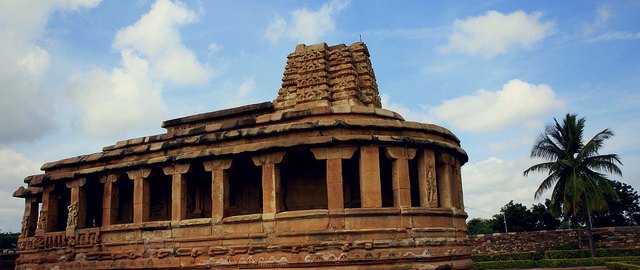
Aihole Pattadakal Badami : Chalukyan Temples & Caves
Moving on from the fabulous ruins left behind by the Vijayanagara Empire, we visited the temples and caves built by the Chalukyan Empire between the 5th and 8th centuries in the towns of Aihole, Pattadakal and Badami. To save on time, we hired a car from Hampi and toured the first two towns along the way before being dropped at Badami for the night. However, the road from Hampi until we got to NH13 was so pot-holed and riddled with truck-traffic that it took us nearly 4 ½ hrs to cover just about 120kms to Aihole; it was a terrible start to the day!
Aihole Temples
Being the earliest capital of the Chalukyan empire, Aihole contains some of the region’s oldest temples. How it got its name is quite an interesting story! One of Lord Vishnu’s Dashavataras (10 avatars), Parusharama, went around killing Kshatriya Kings to avenge his father’s death by the hands of one of them. In this town, which was then called ‘Aryapuram’, he found a pond and exclaiming ‘Aiyyo Hole’ (where Hole means pond in Kannada), washed his axe in its water to (literally) wash away his sins and stop the killing! And that’s how the town got its new name !
The Karnataka govt has enclosed some of Aihole’s best preserved Chalukyan temples, built between the 5th and 8th century, within a nicely landscaped courtyard. Armed with our guidebook, we figured we could look around on our own as most guides were untrustworthy. However, to our luck, we met Mr. Basavaraj, who is a govt-authorized guide, specializing in the Aihole-Pattadakal-Badami region. When he approached us with his offer to guide us through the complex, we immediately liked his sincere tone and reasonable price (Rs.150 per site), so we agreed and never regretted the decision!
Our tour started with the fabulous Durga Temple,  which was built in the 8th century. On hearing its name, we assumed that the temple is dedicated to Goddess Durga, but it actually means Fortress Temple as the word ‘Durga’ also means a Fort. The temple’s shape is unique as it has a semi-circular projection like a Roman church. Moreover, it has a, now partly ruined, curvilinear tower, which is North Indian in style. It is believed that this was added atop the original structure later. A pillared porch runs around the inner shrine and it has fabulous carvings of deities and their different avatars.
which was built in the 8th century. On hearing its name, we assumed that the temple is dedicated to Goddess Durga, but it actually means Fortress Temple as the word ‘Durga’ also means a Fort. The temple’s shape is unique as it has a semi-circular projection like a Roman church. Moreover, it has a, now partly ruined, curvilinear tower, which is North Indian in style. It is believed that this was added atop the original structure later. A pillared porch runs around the inner shrine and it has fabulous carvings of deities and their different avatars.
There are several smaller shrines in the complex but none of them have been consecrated as they are all models for the bigger temples. However, there are two other shrines of great importance! One is the Ladkhan temple, which is the oldest shrine in the complex and perhaps one of the oldest we have been to (apart from the rock-cut ones in Ajanta/Ellora). Built in the 5th  century, this temple is dedicated to Lord Shiva with a large statue of Nandi before the inner sanctum. However, in the 19th century a Muslim saint called Lad Khan took residence in it and then the structure was always referred to by his name. The other shrine, Suryanarayana Temple, dedicated to the Sun God, was also absolutely fantastic. Its inner sanctum has no windows or ventilation, however the 2ft tall image of Suryanarayana enshrined in it looks illuminated throughout the day! When we stood before its inner sanctum, we just couldn’t figure out how, with no visible source, there was enough light for us to the image clearly, while the rest of the inner sanctum was buried in darkness – it was truly the work of a genious!
century, this temple is dedicated to Lord Shiva with a large statue of Nandi before the inner sanctum. However, in the 19th century a Muslim saint called Lad Khan took residence in it and then the structure was always referred to by his name. The other shrine, Suryanarayana Temple, dedicated to the Sun God, was also absolutely fantastic. Its inner sanctum has no windows or ventilation, however the 2ft tall image of Suryanarayana enshrined in it looks illuminated throughout the day! When we stood before its inner sanctum, we just couldn’t figure out how, with no visible source, there was enough light for us to the image clearly, while the rest of the inner sanctum was buried in darkness – it was truly the work of a genious!
After this Mr. Basavaraj drove with us to the 6th century, cave-temple called the Ravana Phadi temple. It is dedicated  to Lord Shiva with a Lingam enshrined in the inner sanctum. However, the most striking feature of the temple is the large sculpture of a 10-armed, dancing Lord Shiva with dancing figures of Lord Ganesha and Nandi Bull by its side! Other sculptures include that of a skeletal Bhagirath doing penance for the river Ganges to be brought to the earth, Lord Shiva as Ardhanarishwar and Goddess Parvati as Mahishasura-mardhini. They were all simply marvelous!
to Lord Shiva with a Lingam enshrined in the inner sanctum. However, the most striking feature of the temple is the large sculpture of a 10-armed, dancing Lord Shiva with dancing figures of Lord Ganesha and Nandi Bull by its side! Other sculptures include that of a skeletal Bhagirath doing penance for the river Ganges to be brought to the earth, Lord Shiva as Ardhanarishwar and Goddess Parvati as Mahishasura-mardhini. They were all simply marvelous!
A little further on from the cave, we got the car parked at the base of a hillock, overlooking the village. Then we climbed up on foot to the top where an abandoned Jain temple sits. An inscription in old Kannada, on a side panel of the temple, dates it to be built by Ravikeerthi, a scholar in the court of Chalukyan Emperor Pulakeshi II in 634 AD. We dodged bats and climbed to the roof of the temple via a flight of steps near the inner sanctum. From here we had fabulous views of Aihole and the river Malaprabha far away!
Pattadakal Temples
With the tour of Aihole complete, we drove off with Mr. Basavaraj to the World Heritage site of Pattadakal, which is about 15kms SW from Aihole. Here, all the monuments are enclosed in one large, landscaped area, which made it quite convenient. Mr. Basavaraj explained to us that here the Chalukyan art had reached its zenith and it showed in the exquisite workmanship of the temples. To explain it better, he compared the Aihole monuments to that belonging to a School of Art, the ones at Badami to a High School, the ones here at Pattadakal to a College and the ones in Belur and Halebid (Hoysala temples) to a University.
The group of 8 temples in Pattadakal is situated along the banks of the Malaprabha River. In fact, a gateway near the main temple, Virupaksha, allowed the Chalukyan Kings to take a dip in the river before proceeding 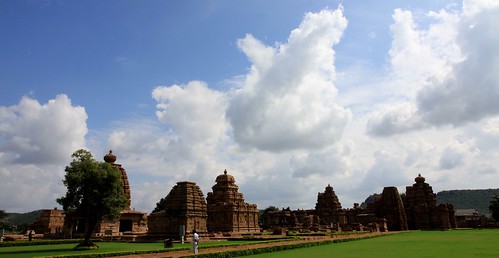 to the temple complex for ceremonies such as coronations. Built in 745 AD, this temple was built by Queen Lokamahadevi to commemorate her husband, Vikramaditya’s win over the Pallavas. In front of the temple is a pillared pavilion inside which is a large seated image of Nandi Bull. The temple has the best carvings ever, depicting scenes from the Ramayana and the Mahabharata. Close to it is the Mallikarjuna Temple, which was built by Vikramaditya’s second queen, Trilokyamahadevi. It is quite similar to the Virupaksha temple except that it’s smaller and its carvings depict scenes from Bhagwata (Krishna’s tales) and Panchatantra (Indian animal fables).
to the temple complex for ceremonies such as coronations. Built in 745 AD, this temple was built by Queen Lokamahadevi to commemorate her husband, Vikramaditya’s win over the Pallavas. In front of the temple is a pillared pavilion inside which is a large seated image of Nandi Bull. The temple has the best carvings ever, depicting scenes from the Ramayana and the Mahabharata. Close to it is the Mallikarjuna Temple, which was built by Vikramaditya’s second queen, Trilokyamahadevi. It is quite similar to the Virupaksha temple except that it’s smaller and its carvings depict scenes from Bhagwata (Krishna’s tales) and Panchatantra (Indian animal fables).
There are several other shrines within the complex, all of which look fabulous. However, the most important feature of the Pattadakal group of temples is that they juxtapose the North-Indian style of temples against the South-Indian ones beautifully. Mr. Basavaraj pointed out the curvilinear shikharas of the North-Indian style and then the stepped one of the South-Indian style – it was quite interesting!
Mahakuta Temple
Before heading to Badami directly, we took a short detour to the Mahakuta temple. Here the temples have been built around a l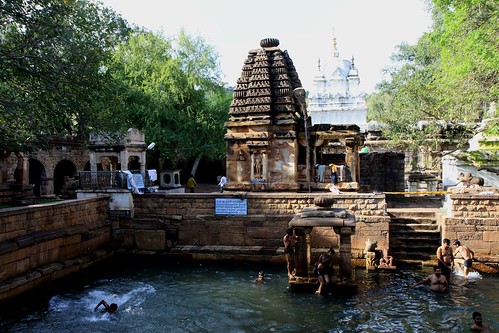 ovely rectangular tank, all of which have been dated to the 6th and 7th century AD. The water in the tank is replenished by a natural spring and looked relatively clean. At the center of it is a small pillared pavilion with a unique Shiva Lingam enshrined within: it has 4 faces of Shiva, one in each direction, carved on it! Among the many shrines within the complex, the Mahakuteshwara Temple is the largest, dedicated to Lord Shiva. Sadly, it is filled with bats and in dire need of some cleanup and care.
ovely rectangular tank, all of which have been dated to the 6th and 7th century AD. The water in the tank is replenished by a natural spring and looked relatively clean. At the center of it is a small pillared pavilion with a unique Shiva Lingam enshrined within: it has 4 faces of Shiva, one in each direction, carved on it! Among the many shrines within the complex, the Mahakuteshwara Temple is the largest, dedicated to Lord Shiva. Sadly, it is filled with bats and in dire need of some cleanup and care.
Overall, the temple complex is beautiful and atmospheric. However, it was quite crowded when we got there, with young lads splashing around in the water tank boisterously. So it wasn’t a very peaceful visit!
Most visitors to the area manage to tour Aihole, Pattadakal and Badami in a single day, which I think is quite possible. But since we were in no real rush to get anywhere, we decided to go a little slow. After visiting the Mahakuta temple, we checked into Badami’s KSTDC hotel for the night. The dusty little town has nothing to offer except for friendly locals (including the staff at the hotel). We walked around looking for a place to eat and were directly to a tiny (but busy) joint, Laxmi Vilas, that served good South Indian fare. After that there was nothing else to do except return to the hotel and relax.
Badami
Formerly known as Vatapi, Badami was the capital of the Chalukyan Empire between the 6th and 8th century. Our guide claimed that the name Badami comes from the almond-colored hues of the red sandstone hills that surround the town; they look quite stunning! But the caves that have been carved into them are even nicer!
There are four caves in all. Cave 1 is dedicated to Lord Shiva, 2 & 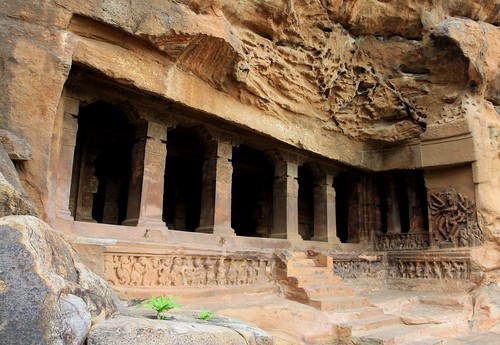 3 to Lord Vishnu while Cave 4 is dedicated to Mahavira. The 18-armed dancing figure of Lord Shiva in Cave 1, depicting 81 Bharatanatyam poses, with Ganesha and Nandi dancing at his feet, was absolutely mind-blowing! The Vishnu shrines had the usual carvings of the various avataras but they were all lovely. A seated figure of Lord Vishnu with Garuda sleeping at his feet in Cave 3, the largest cave of the quartet, was absolutely magical! We loved Cave 4 with its marble-like pillars and little figures of the 24 Tirthankars.
3 to Lord Vishnu while Cave 4 is dedicated to Mahavira. The 18-armed dancing figure of Lord Shiva in Cave 1, depicting 81 Bharatanatyam poses, with Ganesha and Nandi dancing at his feet, was absolutely mind-blowing! The Vishnu shrines had the usual carvings of the various avataras but they were all lovely. A seated figure of Lord Vishnu with Garuda sleeping at his feet in Cave 3, the largest cave of the quartet, was absolutely magical! We loved Cave 4 with its marble-like pillars and little figures of the 24 Tirthankars.
The hillock on which the caves have been carved overlooks the  Agasthya Lake around which Badami village is spread. From there we could gaze out upon the village and the lovely Bhootanatha temple complex, which is located picturesquely on the banks of the lake. A few meters before it is a small museum set up by the ASI. It’s nothing great and took us just a few minutes to look through. Later we walked along the banks of the lake to the Bhootanatha temple. Many women were busy taking care of laundry on the ghats of the lake; it was a colorful sight!
Agasthya Lake around which Badami village is spread. From there we could gaze out upon the village and the lovely Bhootanatha temple complex, which is located picturesquely on the banks of the lake. A few meters before it is a small museum set up by the ASI. It’s nothing great and took us just a few minutes to look through. Later we walked along the banks of the lake to the Bhootanatha temple. Many women were busy taking care of laundry on the ghats of the lake; it was a colorful sight!
Without noticing the monkeys lurking nearby, as we walked, we pulled out a packet of biscuits and started munching on it. With a biscuit in my hand, I placed the rest of it in the side pocket of my daypack. Suddenly two monkeys materialized out of nowhere and one started trotting towards me, calmly but surely. Petrified, I threw the biscuit in my hand away and he calmly turned towards it, as though that’s exactly what he expected me to do. A second later I noticed that the second monkey was still staring at me. Sure enough, he trotted up to me as well. Madhu tried to shoo and scare him away but he just kept looking at us menacingly and coming closer. Too frightened by now, I immediately reached for the rest of the biscuits and threw those away as well. Within seconds both monkeys disappeared with the bounty! I felt like I had been ambushed and robbed by seasoned, biscuit-robbers !
A few meters before the Bhootanatha temple, there were a couple of other shrines to our left. They seemed to be well preserved with fenced gates and landscaped courtyards. However, the caretakers keep the temples locked either because there’re never enough visitors or because they like to get a tip for ‘specially’ opening the temple doors for the occasional visitor. The Bhootanatha temple complex, thankfully, was open. It is quite pretty but doesn’t have any sculptures or carvings of note. It was nice to simply walk around the temples and enjoy the lake setting. Mr. Basavaraj mentioned that some parts of the Hindi movie ‘Guru’ were shot here within the temple complex and in the surrounding hills.
On our way back, we noticed that to the left of the museum, 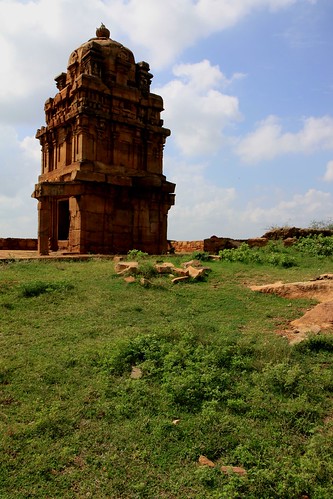 some steps led up the neighboring hillock to more ruins. We climbed about half way till we came across a lovely Watch Tower. Four teenaged girls stood near it, looking quite agitated. Apparently, a monkey had stolen one of their bags and was now guarding over it fiercely. When one of the girls tried to get near the bag, the monkey actually chased her baring his teeth – it was a frightening sight! We advised the girls to call the security guard at the base of the hill for help as he could try to frighten the animal away with a long, wooden stick! After that, we realized that the hill was infested with monkeys who were moving about in large groups. Since Madhu and I were the only ones out there at that time, I felt a little too scared to proceed any further. So we turned back !
some steps led up the neighboring hillock to more ruins. We climbed about half way till we came across a lovely Watch Tower. Four teenaged girls stood near it, looking quite agitated. Apparently, a monkey had stolen one of their bags and was now guarding over it fiercely. When one of the girls tried to get near the bag, the monkey actually chased her baring his teeth – it was a frightening sight! We advised the girls to call the security guard at the base of the hill for help as he could try to frighten the animal away with a long, wooden stick! After that, we realized that the hill was infested with monkeys who were moving about in large groups. Since Madhu and I were the only ones out there at that time, I felt a little too scared to proceed any further. So we turned back !
As of today, only the temples of Pattadakal have been brought under the UNESCO World Heritage List; applications to get the ones at Aihole and Badami under the same list are still pending. I hope the applications get approved, ‘coz the monuments in both these towns are exemplary and they definitely need the protection and funding that a UNESCO status offers. Karnataka’s Hoysala, Vijayanagara and Chalukyan Empires have left behind some of the best architecture to be found in South India. Hopefully, the government will do more to preserve and protect them!
Additional Pictures : Aihole, Pattadakal, Mahakuta, and Badami


No comments yet.